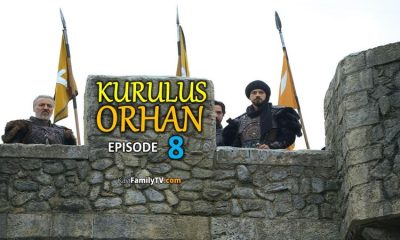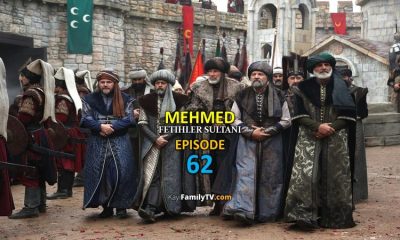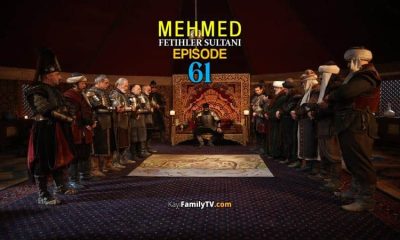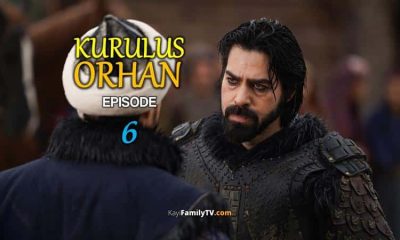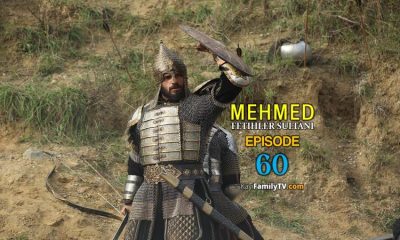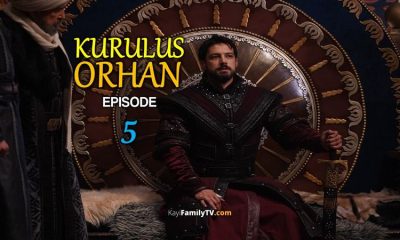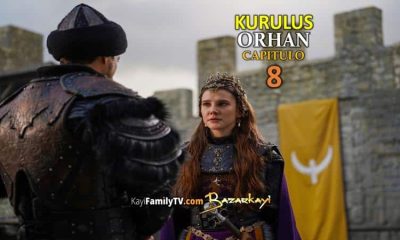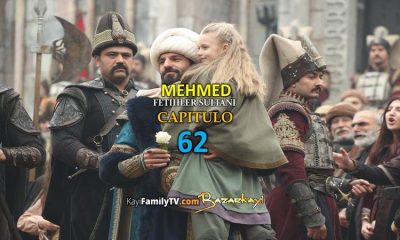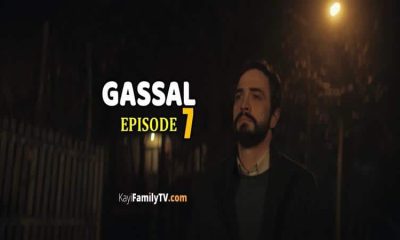Melisa Dirilish Articles
OSMAN GAZI – THE WARRIOR
“You follow my way and protect Din-i-Muhammadi,
the believers and your followers.
Respect the right of Allah and His servants.”
– Osman Gâzi Hân
Osman Gazi, along with his contemporaries [his people and his followers] “lived as authentic Muslims, since they practised its righteousness and, as a result, their adherence to Islam fully continued throughout the early years of the conquests.” [Akgündüz; Öztürk; citation translated by Melisa Dirilish].
Adhering to the Sunnah, taking the Noble Qur’an as their guide, they have set an example, that many were all too eager to follow, either Muslims or non-Muslims. There were many Gazies among his ranks that were born as Christians, but then later joined him in faith, came to share his believes, and some even formed blood ties with his family.
Before 1300’s, as most historians agree, Osman was simply one among many of the Turkmen tribal chieftains in the Sakarya region, but very clever and much more charismatic then the rest. Unsurpassed in his skills as a horseman, swordsman and warrior, an expert in battle strategies, an expert at making both war and peace, a complex and formidable commander, he was “very much a warrior in the mould of other great warriors of the Medieval times (like Genghis Khan used to be before he built his great empire).” Becoming famous across the Islamic world over the years, for his generosity, for his protection of the poor and vulnerable, his steadfastness and bravery, as well as his sense of justice, he compelled many people and many tribes to join his cause.
Osman Gazi was aware that due to two major issues, he could not expand throughout the entire Anatolia and establish his dominance over the region. On the one hand, he was surrounded by much larger principalities, more powerful Turkmen Beyliks that could easily swallow him up. On the other, there were the Mongols, who were terrorizing and vandalizing all of Anatolia.
He also could not break into Rumelia because of the Byzantine Empire, the longstanding rulers and military power in that region.
He was also aware that his rule was essentially preserved only by the Seljuk’s Sultan, the Sultan who himself was not very stable on his throne.
Nevertheless, Osman Gazi was able to bypass all that and to keep expanding further and further, by devising and employing several clever strategies. Sticking to his primary strategy “Peace with Muslims, war with infidels” and to his second strategy that stemmed from his faith and which has been summed up in the famous utterance: “Osman [Ottomans] loved the poor” (Oruç Beğ – “Tarihi”), he then followed his third strategy of increasing his territories at the expense of the Byzantines.
His early tactics were to test the Byzantine defence by launching small night invasions into Byzantine Anatolia, and to wage a slow but relentless war against that great neighbouring Empire. It was only towards the end of Osman’s life that they began employing the art of siege-warfare, with the nine-year long siege of the city of Bursa (1317-1326), being their 1st.
The siege itself took so long because of their inexperience in this new kind of warfare. Osman Gazi masterminded and put in motion the siege, but he assigned the command and control of this siege to his son, Orhan Alp. However, Osman Gazi succumbed to his long-standing Nikris (gout) disease and passed away, 2,5 years before the fall of Bursa. [Tevârîh-i Âl-i Osmân]
Pinning Byzantine rulers against each other, this hitherto unknown chieftain of one minor Anatolian tribe would render them incapable of withstanding his assaults. Osman and his followers would then concentrate on taking their fortified townships, one at a time. Thus, in turn they gradually weakened that once-great Empire, crushing its morale in the process.
Initially, these raids gained Osman and his followers a great support from other Turkmen Beys in the vicinity of his small Beylik. But, soon enough, other Turks running away from the Mongols’ invasion began to settle in these lands that were by then poorly defended by the Byzantines. And, due to that fact, and due to his great diplomatic skills he was eventually able to attract people and to raise vast numbers of troops.
As the Turks began taking chunks of land from the Empire, they were regarded as saviours by the people of Byzantine’s Anatolia, Christians and non-Christians alike. They became known for their just administration… known to bring justice and fairness as per the teachings of Islam, to advocate religious freedom, to support a multicultural background and establish new, more efficient and lively trade routes in every newly conquered land, … all of which people have been only too ready to accept. They brought relief to people who had lived under a lot of strain, due to the severe burden of heavy tax policy and military expenses that the Emperor has imposed on them. So, many of them soon converted to Islam, thus further destabilizing the Byzantine’s power.
In consequence, with the weakening Byzantine’s defence on its eastern frontier and its declining morale, and also aided by the fact that Byzantine’s funds were greatly exhausted due to the Emperor’s great spending, the Turks led by Osman Gazi quickly gained the upper hand and continued to slowly advance along and beyond the western Anatolian border, deeper into Byzantine territory. [Mufassal Osmanlı Tarihi I. Cilt]
It was a long and slow progress, and they too had a lot of martyrs. But, due to their deep sense that the homeland is where the martyrs’ blood was spilled, where their graves were, Osman Gazi and his contemporaries never turned back from their path.
So, fighting fiercely to keep a firm hold on every acre of land he conquered along the way, Osman has opened the way for the spread of Islam… and the emergence of the greatest Empire began to gather momentum.
In support of this just administration of Osman, a renowned historian, Prof. Dr. A. Şimşirgil, quoted one of the first Ottoman historians, Ahmedi, who, in the introduction to his Chronicle: “Dastan and Tevarih-I Mülilk-I Al-I Osman” stated:
” When the mask of law and order is dropped over oppression
The public would easily then pass it for justice.
The story of the Masters of oppression has been told and re-told,
Now, is the time tell the story about the Masters of Justice, the Ottomans.
Those are both, Muslims and Just,
So, let’s get to know and celebrate these rulers.”
– [Ahmedi, “Dastan and Tevarih-I Mülilk-I Al-I Osman”, c.1390;]
– [translated by Melisa Dirilish]
*** Original text:
“Zulüm, hukuk ve düzen maskesi altına alındığında,
Halk tarafından kolayca adalet düşündü.
Bu zulmün ustalarının hikayesi çok aktarıldı,
Şimdi, Adalet Efendilerine, Osmanlılara söyleyelim.
Hem Müslüman hem de Ddil,
Bu yöneticileri tanıyalım ve kutlayalım.”
– [Ahmedi, “Dastan and Tevarih-I Mülilk-I Al-I Osman”, c.1390. / transmitted by Ahmet Şimşirgil]
Hope you’ve enjoyed your readings
*****
SUPPORT MELISA DIRILISH TRANSLATION
Copyright © 2020 Melisa Dirilish (™) All Rights Reserved.
** I do not own the rights for the photographs.
Melisa Dirilish Articles
THE LIFE OF IBN ARABI
THE LIFE of Ibn ARABI
By Melisa Dirilish
“It is He who is revealed in every face, sought in every sign, gazed upon by every eye, worshipped in every object of worship, and pursued in the unseen and the visible. Not a single one of His creatures can fail to find Him in its primordial and original nature.”
*** Ibn ‘Arabi, “Futûhât al-Makkiyya” ***
Ibn al-‘Arabi, was born as Abū `Abd-Allah Muḥammad ibn Ali ibn Muḥammad ibn al-`Arabi al-Ḥātimī al-Ṭā’ī).
He was a Muslim mystic, philosopher, poet, and writer who came to be acknowledged as one of the world’s most important spiritual teachers. He became known as Muhyiddin (the Revivifier of Religion) and the Sheik al-Akbar (the Greatest Master).
His life can be divided into three periods: his time in the Maghrib (Andalusia and North Africa); time in the Hijaz(Mecca and Medina); and his time in the Mashriq (Anatolia and Syria).
*****
Ibn al-ʿArabī was born in Murcia, southeast Spain, in 1165 AD into the Moorish culture, to the family of a minor official . He was of pure Arab blood whose ancestry went back to the prominent Arabian tribe of Ṭāʾī.
He lived at a time when Andalusian Spain was the centre of an extraordinary cultural flourishing in the West, and at a time of cross-fertilisation of Jewish, Christian and Islamic thoughts.
His contemporaries included Ibn Rushd (Averroes), Abu Madyan, ʿUmar al-Suhrawardi, Ibn al-Farid, Moses Maimonides, and St Francis of Assisi.
*****
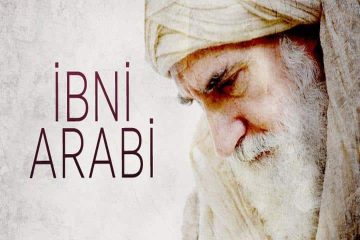
There is a recorded story about Ibn Arabi’s birth. The story goes like this:
His father, Shaykh Ali ibn Muhammad ibn Arabi of Spain had no children and he wished to have a son. At the advice of his Wali he approached Hazrat Ghaus E Azam, to ask for his blessings and prayers to be granted a son.
Hazrat Ghaus E Azam said to him: “I have one more son yet unborn, that is written in my destiny. I will give him to you. So, now rub your back against mine and when the child is born name him Muhammad Muhyiddin. He would grow up to be a Qutb (a spiritual leader) of his time.”
The child was eventually born, as Hazrat Ghaus E Azam has predicted, and was named Muhammad Muhyiddin. He became a great philosopher and a great spiritual leader, as well as the greatest and most important Sufi figures in the Islamic tradition. He gained the title of Shaykh al-Akbar and is commonly known as Ibn al-Arabi.
When Ibn Arabi was 8 years old, his family moved to Seville, which was then an outstanding centre of Islamic culture and learning.
He spent 30 years of his youth and early adulthood gaining knowledge in sciences, mathematics, cosmology, linguistics, and theology. He studied the traditional Islamic sciences, Hadith in particular, with a great number of scholars and mystics.
He also travelled a lot, visiting various regions of Spain and North Africa in his quest for knowledge.
During one of these travels, he found himself in Cordoba with his father, who then took him to meet his friend Averroes. The meeting between young Ibn Arabi and the great Aristotelian philosopher Ibn Rushd (Averroës, 1126–98) was quiet dramatic.
It was recorded that after a long discussion in which young Ibn Arabi explained to the philosopher “the limits of rational perception”, the great philosopher was so taken by the mystical depth and a profound visionary capacity as well as a remarkable intellectual insight of the still beardless young lad, that he “became pale and, dumbfounded, began trembling.”
*****
When Ibn Arabi was about 15 yo, he experienced a sudden mystical “unveiling” (kashf) or “opening” (fotuh) of his soul toward the divine realm, by which he was shaken from his carefree existence.
**In the middle of one of these nightly parties in Seville he heard a voice calling to him, “O Muhammed (Ibn Arabi), it was not for this that you were created.” In consternation he fled and went into retreat for several days in a cemetery. It was here that he had his seminal triple vision in which he met, and received instruction from, Jesus, Moses, and Muhammed—an illumination that simultaneously started him upon the spiritual way and established him as a master of it.**
After yet another vision in which he felt he had been ordered to leave Spain Ibn ‘Arabî departed for the Orient in 1200 AD, never to return to his homeland again. He left Spain for good, with the intention of making the hajj. He passed through Tunis and Cairo and made his pilgrimage to Mecca. He settled in Mecca for the next three years, after he “received a divine commandment” to begin work on his monumental book “Al-Fotuhat al-makkiya” (“The Meccan Illuminations”). During that Meccan period he wrote several more books and essays.
But his major work on “The Meccan Illimination” will last for many years, and that enormous book, a personal Encyclopedia, of 560 chapters and several thousand of pages, was finally completed in Damascus, late in his life.
After this period of contemplation in Mecca , Ibn Arabi travelled around Levant and Anatolia for several years, but never went as far as Persia.
Somewhere along his way, he married a widow whose son Sadr-al-Din Qunawi would become his most influential disciple, and to whom he would bequeath his collection of books.
Finally, in 1223. AD he settled down in Damascus, raised his family, educated numerous students, acted as adviser to Sultans and other rulers and wrote a great number of books, till the end of his life.
*****
Ibn ‘Arabi was and still is one of the most inventive and prolific writers of the Islamic tradition, with as many as 300+ books and treatises attributed to him. However, some 110 works were proved to be genuine works by him. The rest of it still needs further consideration. And the most of all, the small work entitled al-Shajara al-Nu’mâniyya fî al-Dawla al-‘Uthmaniyy, the subject of which is prediction concerning the Ottomans (Uthmans)
His works range from short essays to the long thesis, collection of poetry (Tarjuman al-ashwaq , spanning 5 volumes), collections of Prayers, collection of 101 Hadith Qudsi, … to the Encyclopedic “Al-Fotuhat al-makkiya” ( “The Meccan Illuminations”), and a controversial work that is considered his masterpiece: Fusus al-Hikam (The Seals of Wisdom)
Ibn Arabi was firmly grounded in the mainstream of the Islamic tradition. He cited the Qur’an and Hadith constantly and most of his works are firmly rooted in the Qur’an and represent commentaries on these two sources of the tradition.
He was thoroughly familiar with the Islamic sciences, especially tafsir, feqh, and kalām (Islamic theology) and Greco-Roman philosophy (falsafah)]. And he has profoundly influenced the development of Islam since his time onward.
After his death in 1240, Ibn ‘Arabi’s writings (and teachings) quickly spread throughout the Islamic world within a century, and more slowly throughout Western and Christian world.
Ibn Arabi was buried in Damascus, his resting place can be seen in one of the pictures.
*****
And, one of Ibn Arabi’s poems for the end:
“A garden among the flames”
O Marvel,
a garden among the flames!
My heart can take on
any form:
a meadow for gazelles,
a cloister for monks,
For the idols, sacred ground,
Ka’ba for the circling pilgrim,
the tables of the Torah,
the scrolls of the Qur’án.
I profess the religion of love;
wherever its caravan turns along the way,
that is the belief,
the faith I keep.
[by Ibn Arabi]
.
*****
By Melisa Dirilish
Copyright © 2020 Melisa Dirilish (™) All Rights Reserved.
*****
DONATE MELISA DIRILISH RESEARCH & TRANSLATION
Copyright © 2020 Melisa Dirilish (™) All Rights Reserved.
.
Melisa Dirilish Articles
ERLIK KHAN (ERLEG HAN)
Erlik Khan (Erleg Han) – the second son of “Father Heaven” (Gök or Kök Tengri / Tenger Etseg) and his wife “Mother Earth” (Gazar Eej – Etugan), the core deities in Mongolian shamanism.
According to the Mongolian myth of creation, there were three realms, the “heavenly world” and the “earthly world” (each having 9 levels) and the “underground world” (with 9 rivers “); These realms were connected by the colossal “Worlds’ Tree” (Turge) which they considered the center of the worlds. The World Tree supported the sky and thus connected the heavenly world, the earthly world and, through its roots, the underworld. – [“Altan Tobchi” (Golden Abstract), a 17th century Mongolian chronicle]
Kök / Gök Tangrı is believed to be an eternal blue sky, the supreme being and creator of everything, who assigned power to the Khagans, who created and maintained balance in the universe, the nature, the weather and the seasons. While his wife, Mother Earth (Gazar Eej – Etugan) provided support and nourishment on the grounds below.
They had two sons: Ulgen Khan, Lord of the spirits of the upper world and the creator of the world (land) and Erleg Khan, the Lord of the sprits of the lower world. While Ulgen ruled the Realm of Light, Erleg ruled the Realm of Darkness, and they were associated with the black and white shamans, respectively.
Erlik Khan – the deity of evil, darkness, Lord of the Underworld and judge of the souls of dead people, symbolized a destructive aspect of the Universe, as well as wickedness, greed, ambition and all sorts of evil.
He was also the ruler of the Red Hell (Kizil Tamu), the place where the souls of sinful people go to be punished after they die, and where the enemies were sent to dwell in there eternally. According to the Mongolian belief, some of those souls would be reborn again after a time, some would be elevated to the 3rd level of Heaven (Sky) after enduring their punishment, but extremely evil ones would be extinguished forever.
According to Mongolian Tengrism, Erlik Khan does all kinds of malicious things to people, infects humans and animals with epidemics, and sends grasshoppers to destroy crops. Camel, pig, insects, snake, lizard and some evil spirits are his creations, according to the “Myth of the Creation”. He catches spirits of the people killed or the souls of those still wandering the world of the living, and takes them underground to make them his own servants.
By doing these, he forces people to make ritual sacrifices for him. It is believed that if sacrifices were made and if he is satisfied, he will leave people alone for a while.
While sacrifices are made, the head of the animals being sacrificed to Erlik must be turned to the west, because the Gate to the Underworld has the appearance of a crack in the Earth and is situated to the west. He prefers a black bull, or infirm, weak and sick animals to be sacrificed. A horse is never sacrificed to him, but occasionally the Black Shamans (Kara Kam) would sacrifice a black horse to please him.
In addition, if a person is sick and is at the death door, a Shaman performing shamanic ritual will descend into the underworld traveling along the World River (named Dolbor or Engdekit) or by some other mean, to negotiate with Erlik Khan to bring the person back to life. If negotiations fail, the person will die.
Erlik Khan had nine sons, called Karaoğlanlar (“black boys”), and each of them was a deity of some aspect of the Underworld:
1. Karash Han: The god of darkness.
2. Matır Han: The god of courage and bravery.
3. Shingay Han: The god of chaos.
4. Komur Han: The god of evil.
5. Badysh Han: The god of disaster.
6. Yabash Han: The god of defeat.
7. Temir Han: The god of iron and mining.
8. Uchar Han: The god of informants.
9. Kerey Han: The god of discord.
[Türk Söylence Sözlüğü, Deniz Karakurt]
*****
How Erlik Khan ended up being the Lord of the Underworld is explained in the work “Mongol Creation Myth”, as per Ewenki people:
“Long ago Father Heaven had two sons, Ulgen Tenger and Erleg Khan. Ulgen became the lord of the upper world and Erleg Khan became the lord of the lower world.
At that time the earth was covered with water, there was no land. Ulgen Tenger asked the loon to bring up mud from below the water to create land. But, the loon was not able to do so, and he was punished by having his legs broken so he could not walk.
Then, the goldeneye duck was called next to bring up mud for the land. The duck created a small piece of land that Ulgen was able to lay on. Erleg Khan seeing that his brother had fallen asleep on the new land, tried to pull the land out from under him, but instead the land stretched out in all directions as he pulled it.
Next, Ulgen Tenger created animals and humans out of mud and he spread them out to dry. He created the dog to keep watch over the bodies of the new humans while he was gone.
Erleg Khan, unhappy to see that his brother was creating humans, came to see the new bodies. But, the dog would not let him come close.
At that time the dog could talk but had no fur. It was cold, and snowing, so Erleg Khan tempted him, saying that if the dog allowed him to see the humans’ bodies he would give him a beautiful fur coat. The dog agreed, and was given a shiny beautiful coat. Erleg Khan then spat on the bodies so that humans would have diseases and not be immortal.
When Ulgen returned he saw that the dog had fur and that the humans had been damaged, so he punished the dog by making his coat smelly, taking away his voice, and by making the dog follow humans in order to get its food.
However, Erlik Khan has been forgiven, but because of his jealousy and evil ambition, was sent to the underworld to rule there”
References used and for further readings:
• “The Secret History of the Mongols: A Mongolian Epic Chronicle of the 13th Century”
• “Türk Söylence Sözlüğ”, Deniz Karakurt:
• “Altan Tobchi” (Golden Abstract), a 17th century Mongolian chronicle
• http://www.face-music.ch/bi_bid/historyoftengerism.html
• http://deity-of-the-week.blogspot.com/2011/11/tengri.html
• http://www.zeluna.net/fairy-list-SiberiaMongolia.html
• http://aton.ttu.edu/OLD_TURK_DEITIES.asp
• http://www.hunmagyar.org/turan/tatar/turk.html.
*****
By Melisa Dirilish
Copyright © 2020 Melisa Dirilish (™) All Rights Reserved.
*****
DONATE MELISA DIRILISH RESEARCH & TRANSLATION
Copyright © 2020 Melisa Dirilish (™) All Rights Reserved.
Melisa Dirilish Articles
WHO IS OSMAN BEY
WHO IS OSMAN BEY IN HISTROY?
Osman Gâzi (1299 – 1324)
“Because the one with the fear of Allah, the Creator, has no fear of the created.”
– Osman Gâzi Hân
By Melisa Dirilish
Osman Bey, the first Ottoman Sultan who ruled for 45 years, the founder of the Empire and the dynasty that were named after him, was also known by the names of: Kara Osman, Fahruddin and Muinüddin.
His life, although much shorter than his father’s, since he passed away aged 67 [the exact age of Ertuğrul Gazi when Osman was born], has been an extraordinary one, marked with many achievements and which inspired many legends.
Osman descended from the Kayı tribe of the Boz-Oklar branch of the Oğuz Turks, to which his father Ertuğrul Gazi also belonged, and from which the future Ottomans will emerge. While, his mother Halime Sultan has descended from the Kınık, the Üç-Oklar branch of Oğuz Turks, from which the Seljuks originated. That claim later became part of the official Ottoman genealogy and it was eventually incorporated into the Turkish nationalist historical tradition.
Osman Bey was born in 1258 in Söğüt or Osmancık. He came very late into Ertuğrul’s and Halime’s life. When he was born, Ertuğrul Gazi was about 67 years old, and because Halime Sultan was also older, at an age when women no longer give birth, Osman was considered to be a miracle sent by Allah.
Osman’s birth coincided with a time when “the world of declining empires” was desperate for a new leader.
He was only 23 years old when in 1281, upon the death of Ertuğrul Gazi, he took over the leadership of Kayı Boyu {clan} and the principality of Sögüt, what was then known as the province of Bithynia.
And, from then on, “the roots of the Platanus tree (Çınar) that rose from Osman’s chest, and whose majestic branches would extend across the seas and the lands, the continents and states, began to spread in the soil. So much so that, all humanity lived under the shadow of this Platanus for six centuries, in a way that they couldn’t have even imagined seeing it once again after the age of Bliss (Asr-ı Saâdetten).” [Prof. Dr. Ahmet Şimşirgil, “the Kayi XI”; the citation translated by Melisa Dirilish]
With many conquests he carried out, he extended his territory in a short time, and gradually turned it into an independent principality, then into an independent state.
Firmly controlling the region around the town of Söğüt, he launched his raids from there and waged a slow and persistent war against the neighbouring Byzantine Empire. Osman appears to have followed a strategy of increasing his territories at the expense of the Byzantines, while at the same time he avoided conflicts with his more powerful Turkmen neighbours, until his State become strong enough to deal with them too.
He extended his lands from Marmara coast in the north, to the mouth of Sakarya River and Kutahya in the south. These boundaries included Söğüt, Karacahisar, Yarhisâr, Eskişehir, Harmankaya, Inegöl.
In the years preceding the conquest of Karacahisar fortress, Osman suffered two great private loses which caused him a great grief. His young nephew, Bey Hoca, the son of his brother Savci, was martyred in 1285 in the ambush during the Ermeni Beli battle, and sometime later his brother Savci also died in the struggle before the conquest of Karacahisar. [KemâlPaşa-zâde Tarihi]
After he conquered Karacahisar, Yarhisar and Bilecik, he transferred the centre of the Beylik to Bilecik. Years later, in 1301, he founded town of Yenişehir near Bursa and transferred the Sultanate’s headquarters there.
He then gave the governing of the Eskişehir to his brother Gündüz Bey, of town of Sultânönü to his son Orhan Bey, Yarhisâr to Hasan Alp, Bilecik to Sheikh Edebali and Inegöl to Turgut Alp, and took Edebali’s grandson Ala’addin (his son) with him.
Afterwards, he continued to increase his territories, and as per today’s Mülkî Taksimat (state’s office assets records), the lands of Osmanli domain [Osmanoğulları’nın ülkesi] at the time of Osman Khan’s death covered the districts of Bilecik, Eskişehir (administrative centre), Sarkaya with the attached Geyve, Akyazı and Hendek, Kütahya-Domanic and the province of Bursa, encompassing districts of Mudanya (including the port), Yenisar and Inegöl. [Prof. Dr. A. Şimşirgil, – Osmân Gâzî Hân’ın Şahsiyeti]
When the Seljuk State was brought to an end by the Ilkhanid’s ruler Ahmad Ghazan in 1308, the Osman’s Principality became completely detached.
During his amazing life, Osman Gazi has been addressed by the titles of Emir and Bey. And, at his death he was titled Khan and Sultan, the 1st Sultan of Ottomans. Because, by the end of his life he had become The Bey of Principality, in his own right.
He first became a semi-independent governor, when the Seljuk Sultan Gıyaseddin Mesūd II recognised his rule in 1284, and sent him an envoy with a Mehterhane (military band), the Tuğ (the Tugh – symbol of duty, office and sovereignty) and a Sancak (Sancak/Sanjak – a military flag) as a gift, and also his decree that Söğüt and its environs were allocated to him. [Tevârîh-i Âl-i Osmân]
The first legitimation of Osman’s rule on the part of the Seljuk Sultan, happened during the siege of Karachahisar, when the next Seljuk Sultan Alaaddin Keykubad III, summoned him and said that he displays many signs of success [bliss], adding “You and your family are unique in their kind. My prayers, Allah’s help, the Evliyaullah’s support [Allah’s aleem/ulamā’/wise men] and Muhammed’s miracles are with you”. [Âşıkpaşa-zâde]
And then, several years later, on 27 January 1300, Sultan Alaaddin Keykubad III sent him an edict, along with another Tuğ, Sancak and a drum (as the symbols of his sovereignty), by which Osman Bey became an independent Principality Bey.
After gaining his independency, he proceeded to mint his own coins (Akce) with the inscription “Minted by Osman, son of Ertuğrul”, and had Jummah prayers recited in his name only.
Osman’s last campaign, before dying, was against the Byzantines in the city of Bursa. He masterminded and put in motion the siege of Bursa, which would last for 9 years (1317-1326), and then he left the battlefield under the command of his son, Orhan.
However, since he was long suffering from Nikris (goutte) disease, his health deteriorated towards the end of the siege, and he passed away in February 1324, before seeing the fall of Bursa.
He was buried temporarily in the graveyard next to Ertuğrul Gazi’s tomb. But Osman last request addressed to his son on his deathbed was that Osman re-bury him in Bursa, after he conquers it. So, 2.5 years later his remains were taken from Söğüt and re-buried in in the old Eastern Roman chapel, known as “Gümüşlü Kümbet”, in Bursa, in 1326. [Osmanlı Araştırmaları Vakfı]
With the conquest of Bursa, on April 6th 1326, which heralded the founding of the Ottoman Empire, the Ottoman Turks have finally established themselves as the major power in Asia Minor. And Bursa, in later history recognized as the birthplace of the Ottoman Empire, became the new Ottoman capital until the conquest of Adrianople (today known as Edirne) in 1362, by Osman’s grandson, Sultan Murad I.
The physical and spiritual foundations of the State he left after his passing, were so strong that only 150 years later it would became a superpower and eventually one of the greatest world’s Empires, which lasted for more than six centuries and spread across three continents.
“If this smallest of unions (beyliks) among the Anatolian principalities, has made claim back then, that they would be the ones who would ensure the Turks’ unity and that they would defeat many states in Europe and Asia and dominate in these regions, no one would have believe them, they would say: ‘You are dreaming!’. However, this distinguished Turk’s hero, surrounded by the Sufi masters, and backed by his Gazi-Alps and many valiants ready to sacrifice their lives for this cause, has believed in this and strived hard for this great birth.” [Prof. Dr. Ahmet Şimşirgil; Kayı XI; the citation translated by Melisa Dirilish]]
The subject of Osman Gazi is really huge, with a lot of material to cover. It could not fit in just one or two articles, as can be seen from this one, so I will write it as a series of articles, as the show “Osman, the Founder” goes on.
And, as always, I won’t use any of the foreign sources which are full of subjective information, but the Turkish sources and archives which are well documented and include more facts than legends.
*****
By Melisa Dirilish
Copyright © 2020 Melisa Dirilish (™) All Rights Reserved.
*****
SUPPORT MELISA DIRILISH TRANSLATION
Copyright © 2020 Melisa Dirilish (™) All Rights Reserved.

 Kurulus Orhan Espanol2 weeks ago
Kurulus Orhan Espanol2 weeks agoKurulus Orhan Capitulo 7

 Kurulus Orhan Espanol6 days ago
Kurulus Orhan Espanol6 days agoKurulus Orhan Capitulo 8

 MEHMED FETIHLER SULTANI1 week ago
MEHMED FETIHLER SULTANI1 week agoMehmed Fetihler Sultani Episode 61

 MEHMED FETIHLER SULTANI ESPANOL7 days ago
MEHMED FETIHLER SULTANI ESPANOL7 days agoMehmed Fetihler Sultani Capitulo 62

 KURULUS ORHAN1 week ago
KURULUS ORHAN1 week agoKurulus Orhan Episode 7

 MEHMED FETIHLER SULTANI1 day ago
MEHMED FETIHLER SULTANI1 day agoMehmed Fetihler Sultani Episode 62

 KURULUS ORHAN7 hours ago
KURULUS ORHAN7 hours agoKurulus Orhan Episode 8















